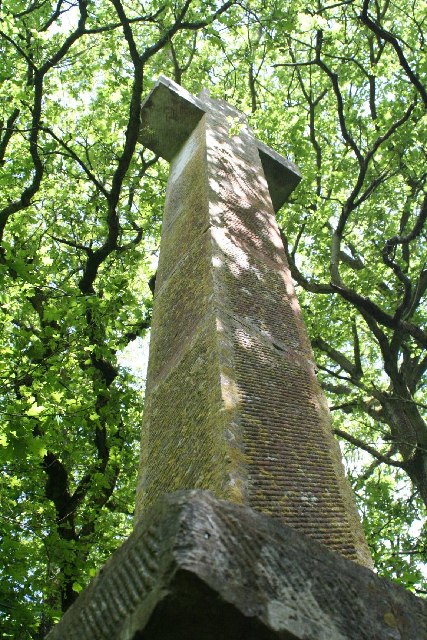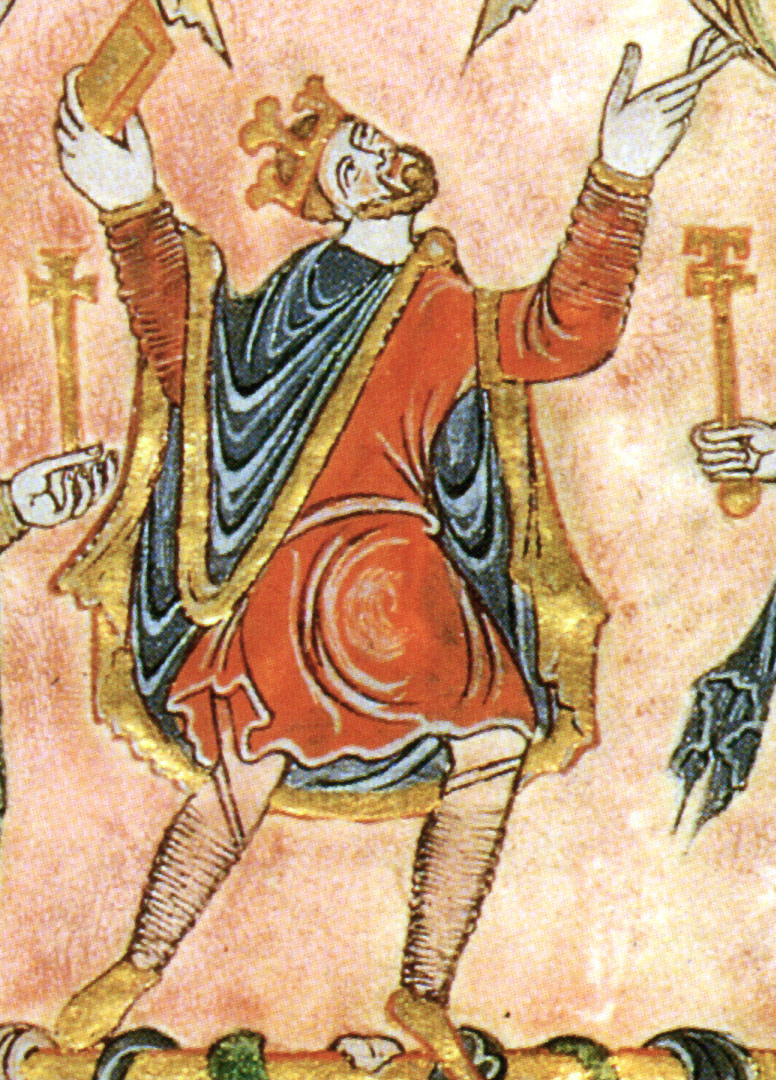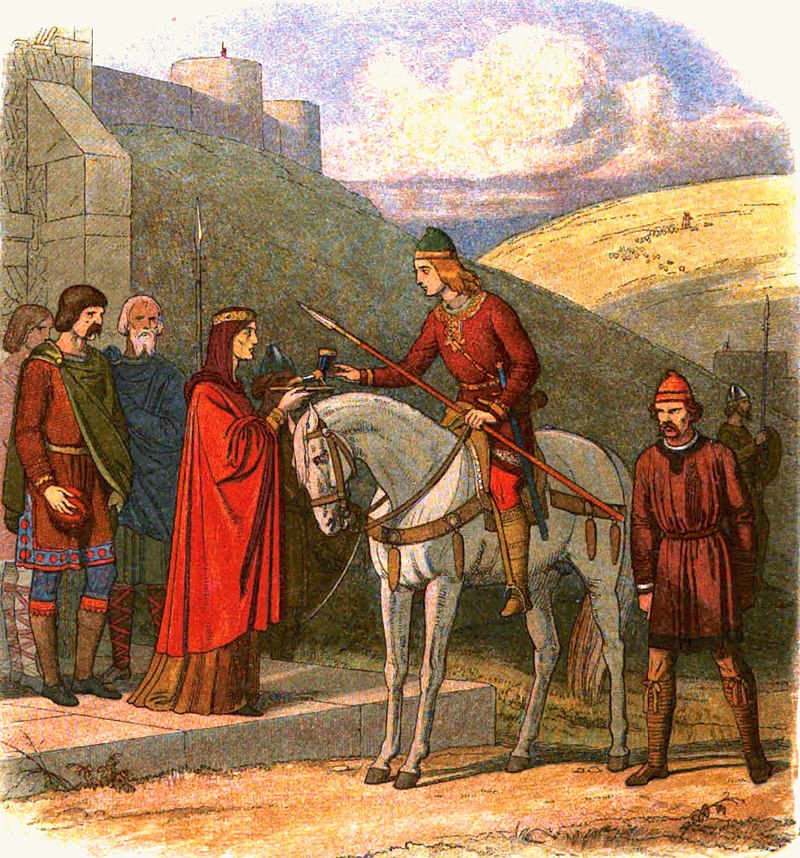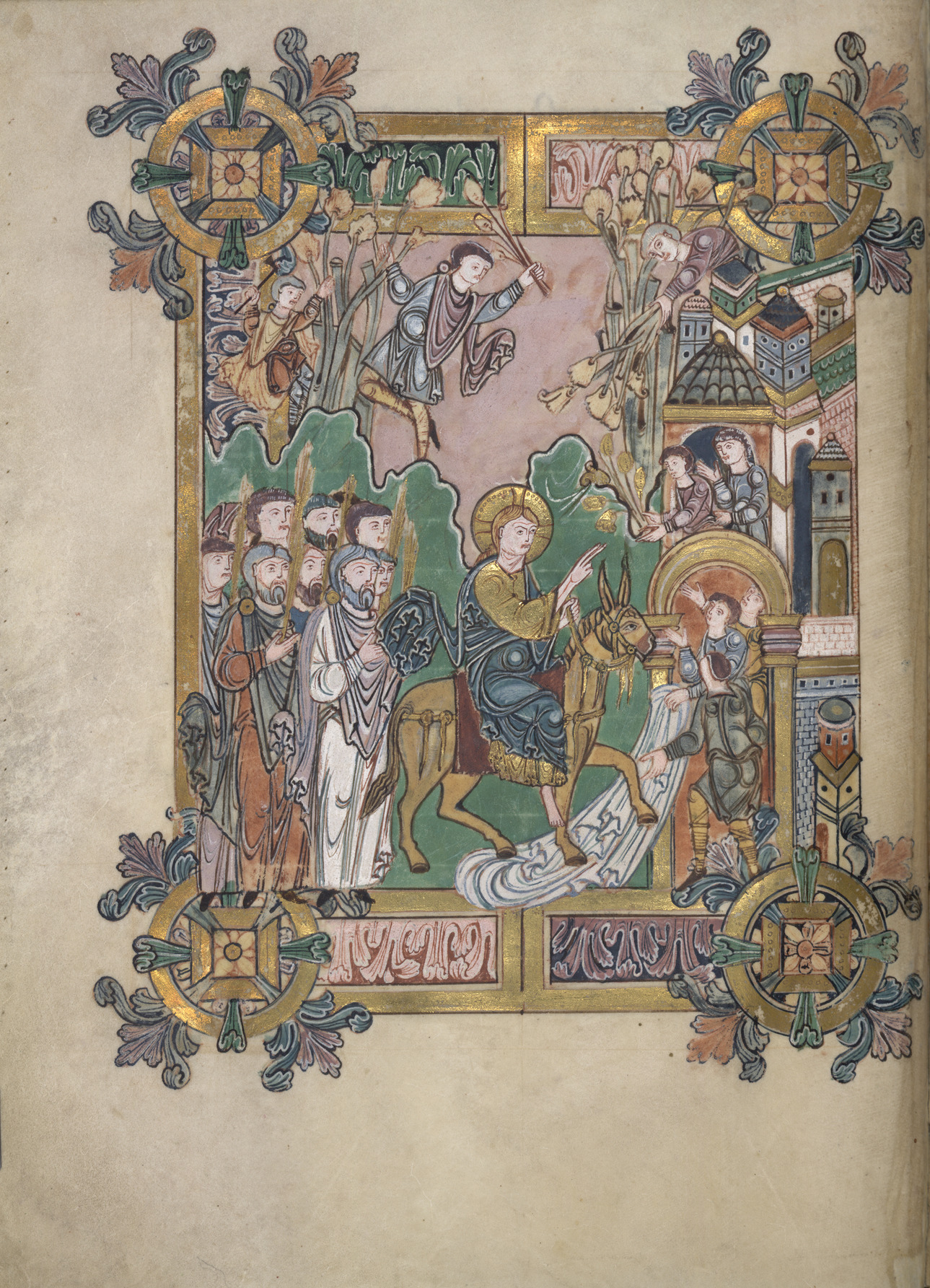On 18 March 978, King Edward of England set out to visit his stepmother and young half-brother at Corfe, Dorset, arriving in the evening. He never even dismounted from his horse. His hostess, one of the most powerful of Anglo-Saxon queens, would soon be remembered solely for his murder.
The woman that Edward came to visit was Elfrida (or Ælfthryth), an English noblewoman who came originally from Devon. She was of royal descent on her mother’s side, but not born to queen. Although no contemporary depiction of her survives, Elfrida was renowned for her beauty. Her attractiveness was so famed that, in her youth, she attracted the attention of Edgar, the new king of England. According to later accounts, he sent his friend, Ethelwold, to visit her to determine whether she was worthy of him. The young nobleman fell in love, informing the king that Elfrida “was misshapen, ugly, and dark,” before seeking permission to wed her himself.
Elfrida’s new husband was the eldest son of Athelstan, ealdorman of East Anglia, who was the most powerful nobleman in England and nicknamed the ‘half-king’. Elfrida’s father-in-law was, as one Anglo-Saxon writer put it, “a man of such authority that he was said to maintain the kingdom and its rule with his advice to the king.” He ruled an area the size of Normandy with little royal interference. It was an excellent match for Elfrida.
King Edgar agreed to stand as godfather to Elfrida and Ethelwold’s first son. But, as further reports began to reach him of the woman’s beauty, he grew suspicious, resolving to see her for himself. It is impossible to know the truth of what happened at the pair’s meeting, with the only accounts written more than 100 years after the events they described. One record claims that Ethelwold begged Elfrida to dress in her ugliest clothes, but she defied him by appearing in all her finery.
Edgar and Elfrida soon fell in love. Later sources would accuse Edgar of murdering his rival – in one version running him through with a javelin while hunting. A more plausible account suggests that he died of a sickness with his wife at his deathbed. What is certain is that Elfrida was widowed in 962 and that two years later she took a new, higher-status husband.
While Elfrida’s first husband died, probably of natural causes, her second husband, King Edgar, certainly rid himself of a wife to marry the pretty widow. Edgar was the younger son of King Edmund I and would have been around the same age as Elfrida. Both Edgar’s parents died while he was an infant and he was raised in the household of the pious half-king, who inspired a deep regard for monasticism in the young prince.

By 956, when he was still a young teenager, Edgar began to take an active role at his elder brother’s court and he soon began to be seen as the figurehead of a monastic reform party, led by his grandmother, queen dowager Eadgifu, and Dunstan, abbot of Glastobury. In 957, the two former Anglo-Saxon kingdoms of Mercia and Northumbria rebelled on Edgar’s behalf, naming him as their king. In the midst of continuing political turmoil, Edgar’s brother, Eadwig, died in 959, leaving him as sole king of England.
Edgar took a wife at around the time of his accession, with his eldest son, Edward, born in the early 960s. This first wife either died soon after or was divorced, since Edgar was quickly married to a noblewoman named Wulfrida (or Wulfthryth). She bore him a daughter, but was soon repudiated and sent to the nunnery at Wilton where she remained as abbess for the rest of her life. Wulfrida’s divorce cleared the way for Edgar and Elfrida to marry, although the circumstances led Dunstan, who had been promoted to archbishop of Canterbury, to accuse the couple of adultery. Dunstan would remain Elfrida’s enemy until his death.
Some accounts claim Elfrida was crowned shortly after her marriage, with the couple making efforts to assert the legitimacy of their union. Elfrida’s two sons by Edgar – Edmund (who died young) and Æthelred – were soon being described as the king’s ‘legitimate’ sons to differentiate them from the elder Edward, who was pointedly merely ‘begotten by the same king’. Elfrida, too, was called the king’s ‘legitimate wife’, while she also received a dower after her wedding, which was made up of a number of estates intended to support her both during her time as queen and after she was widowed.
Elfrida was also given an unprecedented political role by her husband. Edgar was nicknamed ‘the Peaceable’ and his reign was a time of peace, allowing him to focus his attentions on the monasteries, which had been left in a ruinous state following the Viking raids of the 9th century. While Elfrida’s enemy, Dunstan, was the undoubted leader of the reform movement, she was allied to Ethelwold, bishop of Winchester, who would become her greatest champion.
Elfrida came from a family with strong monastic associations, and she later founded two nunneries herself, as well as dedicating her daughter from her first marriage as a nun at Romsey Abbey. The royal couple also jointly commissioned an English translation of the monastic Rule Of St Benedict from Bishop Ethelwold. A further document, the Regularis Concordia, which was drafted by the bishop and set out the rules by which English monks and nuns were to live, appointed Elfrida as ‘the protectress and fearless guardian of the monasteries’ – the first defined political role ever granted to a queen of England. This gave Elfrida power over all the nunneries in England, while Edgar took a similar role in relation to the houses for monks.
Edgar also had imperial ambitions and, in 973, resolved to be crowned for a second time in the ancient Roman town of Bath. The coronation service was revised by Bishop Ethelwold who, predictably, gave the queen’s own crowning a prominent place in the rite. After the ceremony, which once again highlighted Elfrida’s place as Edgar’s legitimate queen, she dined at a table with all the abbots and abbesses, who presumably included Edgar’s ex-wife, Wulfrida. Shortly afterwards, the couple moved to Chester, where Edgar met with eight client kings of Britain, including the king of Scots, who ceremonially rowed him down the River Dee to emphasise their subject status.

Edgar was still a young man at the time of his second coronation, and would have expected to live for many years. It was a shock, therefore, when he was ‘suddenly snatched from this world’ on 8 July 975, an event by which, as one contemporary lamented, “The commonwealth of the entire realm was shaken.” Edgar had almost certainly intended his surviving son by Elfrida – Æthelred – to succeed him, but he was then aged only seven. His elder son, Edward, who enjoyed the support of Archbishop Dunstan, was around 14 or 15. Despite the efforts of Elfrida and her supporters, Æthelred’s age was against him and, in March 976, nearly a year after Edgar’s death, Edward was crowned as king.
Dunstan and his supporters hoped that Edward’s coronation would neutralise support for Æthelred and bring the country back into order, but the kingdom soon slipped into a state of near civil war. Elfrida and Æthelred’s whereabouts are largely unknown during Edward’s reign, although the pair did visit the monastery at Ely with Bishop Ethelwold on at least one occasion.
Elfrida’s kinsman, the powerful Ealdorman Elfhere, who had supported Æthelred’s claims, was caught off guard by Edward’s coronation, but immediately exploded into violence against the new regime. Recognising the wealth and political importance of the newly refounded religious houses, he focussed his attacks on them, aware that, by doing so he also attacked Dunstan and the other leading churchmen who supported Edward. At this time, a comet was reportedly seen in the sky, which was taken to bode ill for the country, while bad weather caused the crops to fail, leading to famine.
Finally, the king’s supporters called a council in Calne, Wiltshire, in 978 to try to restore order, only for the floor to collapse in the upper room in which the churchmen and nobility assembled. Only Dunstan, who was fortuitously standing over a rafter survived unhurt, with the majority of Edward’s leading supporters either killed or maimed for life. Dunstan hailed his survival as a miracle, but this positive spin did little to mask the extent of the disaster. The accident at Calne allowed the young king’s opponents to once again look towards his half-brother, Æthelred, who was then staying with his mother in her house at Corfe in Dorset.
Although Elfrida had kept a low profile during much of Edward’s reign, she remained a considerable political force in England. It may have been with a view to coming to terms with his stepmother that, on the evening of 18 March 978, Edward arrived to visit her at Corfe with only a small escort. What happened as he arrived at Elfrida’s residence is shrouded in centuries of exaggeration, although the earliest full account was written only a few years after Elfrida’s own death, while her son was still alive.
According to this source – Byrhtferth of Ramsey’s Life Of St Oswald – when Edward arrived, the “nobles and chief men, who stayed with the queen” came out to meet him. They surrounded his horse and, as the young king reached for a cup with which to drink, one man pulled his right arm towards him, as if he wished to offer the king a kiss of welcome. Another then seized his left arm roughly, stabbing him.

“What are you doing – breaking my right arm?” the king cried out in alarm, as he was set upon by the men, before he tumbled backwards over the saddle. The teenager’s foot was still caught in the stirrup and as his mount bolted, Edward was dragged to his death along the road for some distance. It was an inglorious end. The nature and extent of his injuries were largely confirmed in the 1930s when Edward’s remains were discovered during excavations at Shaftesbury Abbey.
None of the early accounts of the murder lay the blame at Elfrida’s feet, although the place of Edward’s death and the fact that it was carried out by her own followers was ominous. It was only by the mid-11th century that reports began to declare that the young king was, “killed by a stepmother’s deceit.” Over the centuries, a greater and greater role was assigned to the queen, until she was actually placed in the courtyard, “alluring him to her with female blandishments” and offering Edward the cup to drink herself, while signalling for her attendants to stab him. Accounts contemporary to Elfrida or her son tend, instead, to blame the pair for failing to properly investigate the killing and giving Edward an ignominious burial at Wareham, rather than specifying that the queen was involved in its planning.
One thousand years on, it is impossible to be certain about Elfrida’s guilt. She certainly played no role in actually carrying out the deed, but may have ordered the murder. Equally, her kinsman, Ealdorman Elfhere, who was still in active rebellion against Edward, had no reason to love the young king and could have acted independently. Elfhere was later surprisingly prominent at Edward’s ceremonial reburial at Shaftesbury Abbey in February 979, which was intended to draw a line under the matter and reconcile the various parties.
Regardless of guilt, it was Elfrida and Æthelred who were the main beneficiaries of Edward’s death. While some of Edward’s supporters attempted to place Edgar’s daughter by Wulfrida on the throne, most recognised that the crown was Æthelred’s. The boy king was crowned at Kingston upon Thames on 14 April 979 by a reluctant Archbishop Dunstan. The 11-year-old acquitted himself well, showing “fascinating manners, handsome countenance, and graceful appearance,” but it must have been clear to everyone that he was too young to govern.
Although there was no official regency in place, Elfrida and Bishop Ethelwold were the power behind the throne, with the court packed with their supporters. Elfrida usually referred to herself as ‘the king’s mother’ in charters granted in Æthelred’s minority, while she may have gained a certain sense of satisfaction that she was always asked to witness the documents before Archbishop Dunstan. During the period, Elfrida and Bishop Ethelwold sought to continue the monastic reform movement, with the refoundation of the great Old Minster at Winchester completed in 980, an event that the king and queen mother both attended.

Æthelred could have been expected to attain his majority at around the age of 15 or 16, as his uncle, King Eadwig, had done before him. Both birthdays passed, however, with the young king still firmly under his mother’s control. The death of Bishop Ethelwold on 1 August 984, who had always been Elfrida’s champion, gave Æthelred the chance he needed to assert his authority and by the end of the year, Elfrida no longer attended council meetings and had retired to her own estates. She lived quietly between 984 and 993, while the king showed his displeasure in his mother by confiscating much of the property that had been given to the monasteries during his and his father’s reigns. The young king would later blame his actions on the men who offered him counsel in the period.
Although there was clearly some estrangement between Elfrida and her son, she was entrusted with the care of Æthelred’s children during the period, who were born to his obscure first wife. One of her grandsons, Athelstan, would later remember her fondly in his will as the woman “who brought me up”, while she appears to have settled with the children at Dean in Sussex.
It was through her eldest four grandsons that she was able to return to some prominence in 993 when she accompanied them to court. By then, England had been harried for some years by devastating Viking attacks and Æthelred had come to regret his conduct over the previous decade, ruefully declaring that the death of Bishop Ethelwold in 984 had deprived the country of a man, “whose industry and pastoral care administered not only to my interest but also to that of all inhabitants of this country.” Elfrida agreed and continued to venerate her greatest friend’s memory until her death.
By the 990s, Elfrida was elderly by the standards of her time. She continued to visit court regularly between 993 and 999, attending council meetings in the company of her grandchildren. She also received grants of land from her son, while she is the earliest queen of England for whom a letter survives. The missive, which was written at some point after 995, concerns a lawsuit in which Elfrida was asked to act as a witness. She also continued to exercise her authority over the nunneries, ordering the expulsion of the abbess of Barking in around 993, for example.
Elfrida retired to the nunnery at Wherwell in around 999, spending her final years in religious seclusion. The most powerful woman of her generation was almost forgotten. She died on 17 November, and while the year remains unrecorded, we know it was between 1000-02.
A graduate of Cambridge and Oxford universities, Elizabeth Norton writes about medieval and Tudor history. Her most recent book is The Lives of Tudor Women. For more on the kings and queens of Medieval Europe, subscribe to All About History from as little as £13.
Sources:
- E Norton, Elfrida, The First Crowned Queen Of England,
Amberley 2013 - D Scragg, Edgar, King Of The English 959-975, Boydell 2008
- H O’Brien, Queen Emma And The Vikings, Bloomsbury 2006
- M Swanton (ed), The Anglo-Saxon Chronicles, Phoenix 2000
- R Lavelle, Æthelred II: King Of The English 978-1016, The History Press 2008
